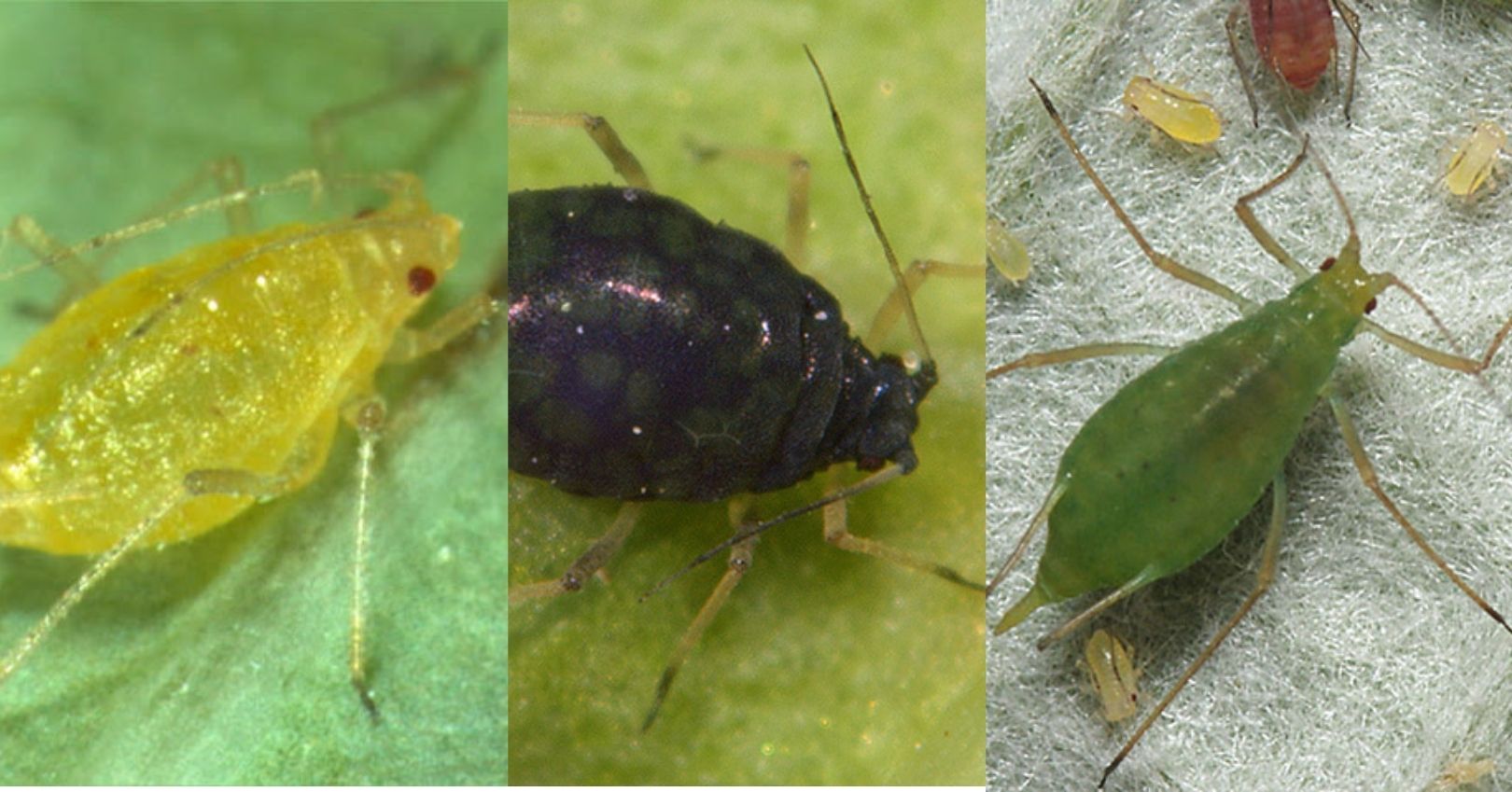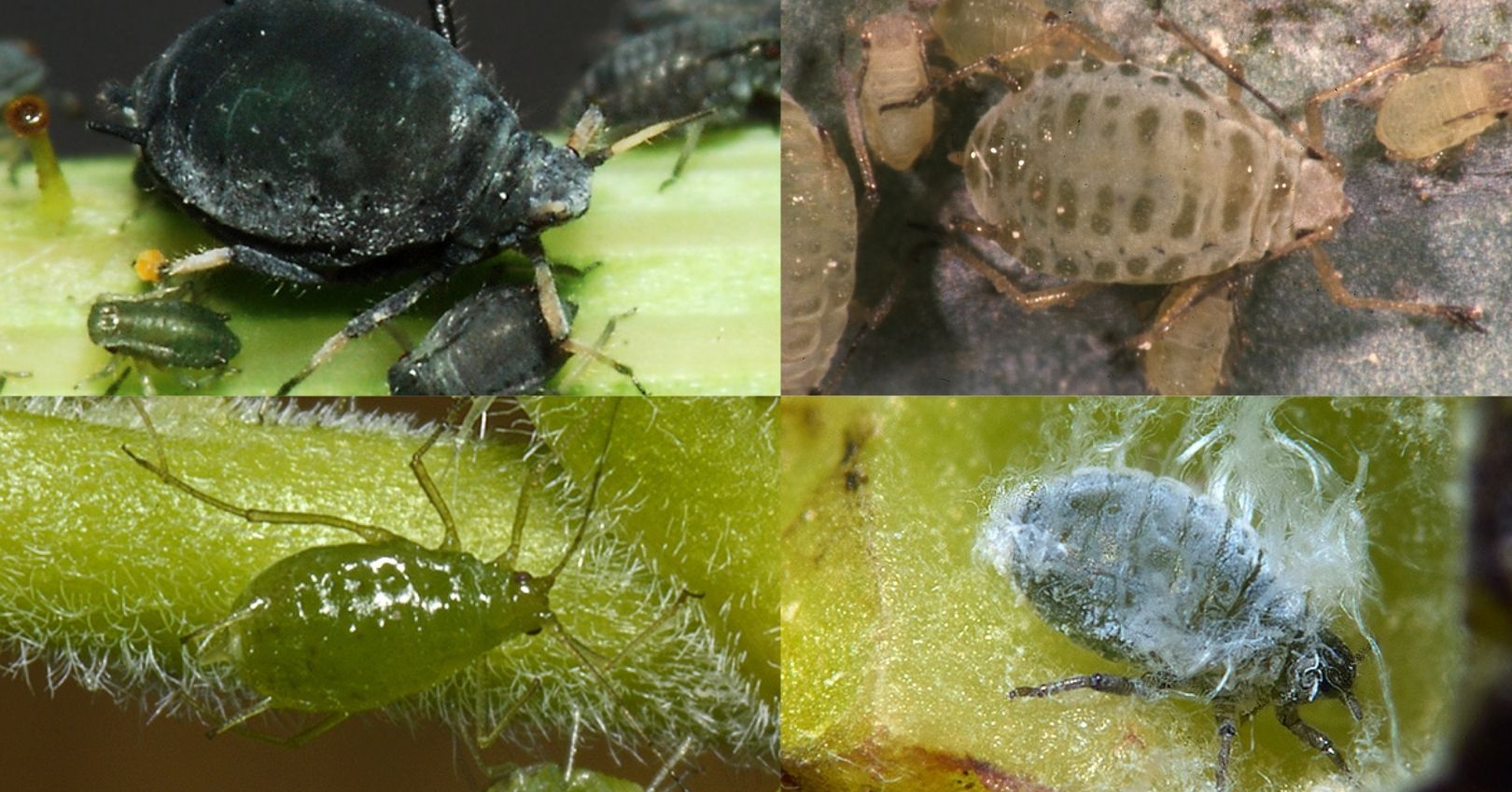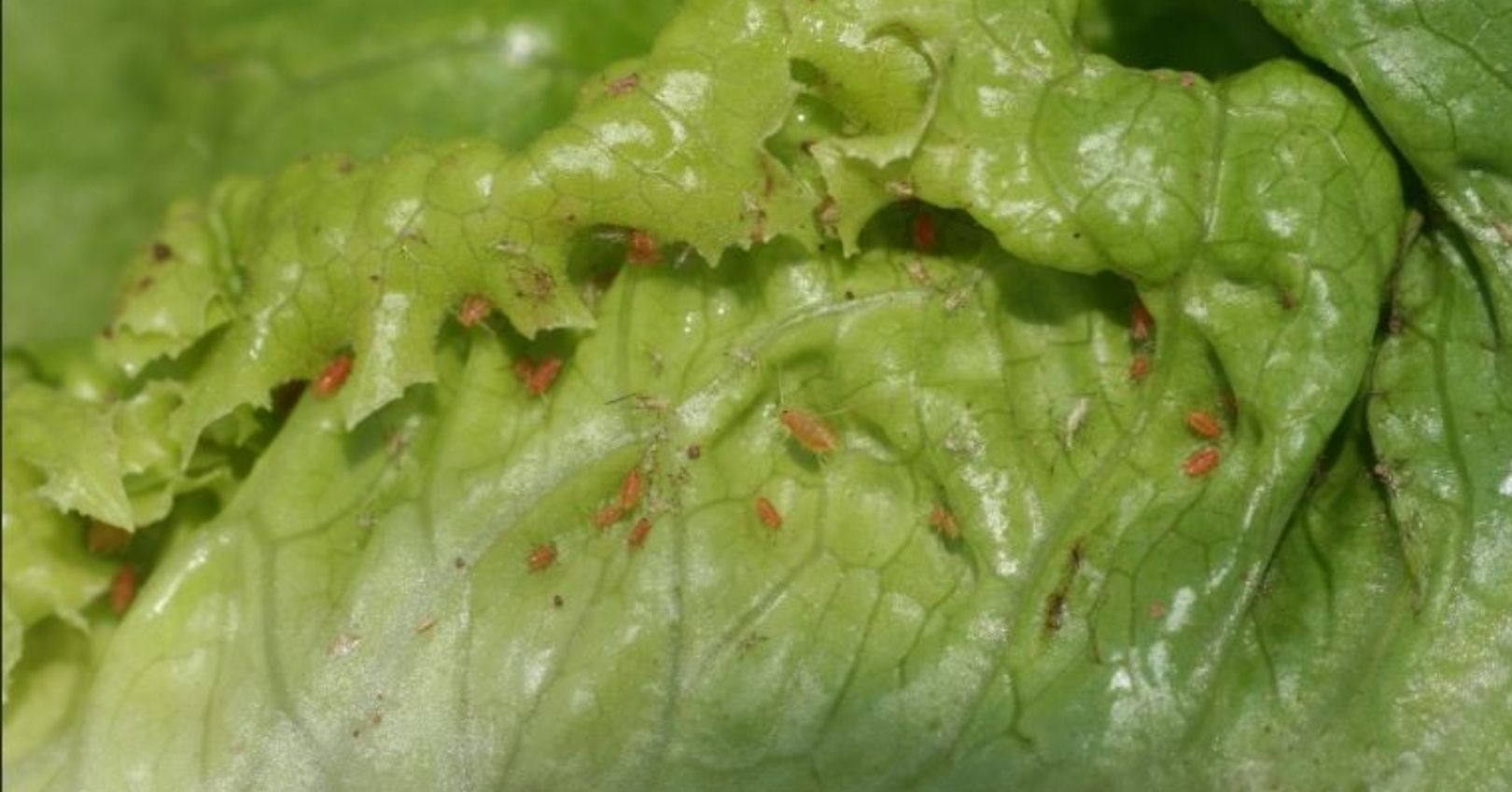Aphids
Cabbage Aphids




Description
Adult & nymph: Green-gray in color with a white waxy coating and short cornicles (two “tail-pipes” on the tail-end of the abdomen). Adults may be winged or wingless. Cabbage aphids form dense colonies on undersides of leaves of broccoli, Brussels sprouts, cabbage, cauliflower, kale, and other related cole crops. Aphids prefer to feed on young leaves and flowering structures; they can occur deep inside the heads of Brussels sprouts and cabbage.
Green Peach Aphid
Description
Adult: Soft, pear-shaped body with red eyes and tailpipe-like appendages called cornicles on the rear of the body. Wingless adults are yellowish or greenish. The winged adult has a yellow-green abdomen, with a large dark patch on its back. It has a black head and thorax and is the same size as the wingless form. The oviparous (egg-laying) form is pinkish.
Egg: Initially yellow or green and become shiny-black as they mature. Eggs measure about 0.02 inches (0.50 mm) long and 0.01 inches (0.25 mm) wide. Eggs are usually deposited near buds of Prunus spp. trees.
Nymph: Similar in shape and color to the wingless adult, but are smaller. Nymphs that develop into winged adults may be pinkish.
Melon Aphid
Description
Adult: Soft-bodied, pear-shaped with dark cornicles. Melon aphid adults are smaller and have shorter appendages than the green peach aphid. Winged adults are about 0.05 inches (1.25 mm) long with yellow to dark green bodies. They have a black head and thorax. Wingless adults are about 0.04 to 0.06 inches (1 to 1.5 mm) long with yellow to dark green bodies.
Egg: Yellow when first deposited, turning shiny black when mature.
Nymph: Resemble adults but are smaller in size, about 0.02 to 0.04 inches (0.5 to 1.0 mm) long
Potato Aphid
Description
Adult: Larger than the green peach and melon aphids, 0.08-0.16 inch (2-4 mm) long with pink or green bodies.
Egg: Similar to green peach and melon aphid eggs.
Nymph: Similar color and shape as adults, but smaller.
Bean Aphid
Description
Adult: Dark olive-green to dull-black. 1.8-2.4 mm long. The appendages tend to be black.
Egg: Initially green, eggs soon to shiny black.
Nymph: Dark, have four pairs of transverse white bars on the dorsal surface of the abdomen.
Turnip Aphid
Description
Adult: 1.4 mm - 2.4 mm long, dorsal surface of the thorax and abdomen of wingless adult females are marked with two rows of dark bands, which coalesce into a single band on the distal abdominal segments.
Egg:
Nymph: Pale greenish-yellow
Lettuce Aphid
Description
Adult: Pale-green to apple green. Winged forms have extensive black or dark pigmentation, including dark head, thorax, and cornicles. Antennae and cornicles are long.
Egg:
Nymph:
Lettuce Root Aphid
Description
Adult: Green, dark appendages. Short antennae are grayish to dark with black head. Dorsals surface bears six longitudinal rows of circular wax glands.
Egg: Elongate oval, orange, 0.48 mm long, and 0.23 mm wide.
Nymph: Green
Aphid Life History
Most vegetable aphid species have similar life cycles. Cabbage aphid overwinters primarily as eggs on debris of cole crops, mustard family plants, or related weed species, and in southern Utah, they may overwinter as adults. Green peach aphid overwinters as eggs on peach, nectarine, apricot, and plum trees. Potato aphid overwinters as eggs on wild and ornamental rose plants. Bean aphid overwinters on Euonymus sp. (burning bush) and Viburnum sp. (snowball bush). Eggs hatch as all females in spring. Adults reproduce asexually, give live birth, and have 2-16 generations. They move from overwintering hosts to vegetable crops and/or weeds for the summer. Winged, migrant aphids develop when food quality declines, crowding occurs, or when they are seeking new plant hosts. In late summer to fall, aphids reproduce sexually to lay eggs for overwintering. Potato aphid populations are generally highest in the spring and fall. Little is known about the overwintering behavior of turnip aphid. Because its appearance and habits are so similar to cabbage aphid, the two species have often not been distinguished. Lettuce aphid overwinters on Ribes spp. such as blackcurrant and gooseberry bushes and lettuce root aphid overwinters on the bark of Lombardy poplar.
Aphid Damage
Aphids contaminate plant parts, leaving them unmarketable. Their feeding may cause stunted, yellowed, distorted, and/or curled leaves and loss of plant vigor. Aphids secrete a sticky substance called honeydew, on which sooty mold fungi may grow. Lettuce root aphids feed on roots of host plants.
Aphid Management
Cultural
- Avoid excess fertilization. Aphid densities tend to be higher on plants that have succulent, vigorous growth.
- Use mulches or row covers. Reflective mulches and row covers can help reduce aphid populations on vegetables by interfering with the ability of winged aphids to find plants.
- Remove/destroy plant debris. Disking fields immediately after harvest will destroy alternate host plants and reduce available aphid and virus sources.
Chemical
Many aphid species in other parts of the world have developed resistance to multiple insecticide groups, including some synthetic pyrethroids, carbamates, and organophosphates. In Utah, use these insecticides sparingly; instead choose products that are less damaging to natural enemies of aphids and non-target insects.
Biological
Natural enemies such as lady beetles, lacewings, syrphid flies, and parasitic wasps play a major role in the suppression of aphids.

